Mongolia's Manly Sports
Clubs and internet cafes have come to the capital, but Mongolia still comes to a standstill mid-summer, when the world's second-oldest Olympics celebrates what defined civilization on the steppes eight centuries ago - horse riding, archery and wrestling.
By Ron Gluckman / Mongolia
THRONGS OF MONGOLS in resplendent robes of blue, red, and maroon swarm Ulaan Baatar's Central Stadium. Archers snap bows, bands blow brass music, and the air is saturated with the pungent odor of mutton, the national dish (the older and tougher, the better).
Yet all eyes are focused on the field, where scores of burly men dance in ill-fitting leather bikini briefs, flapping their arms and hooting wildly.
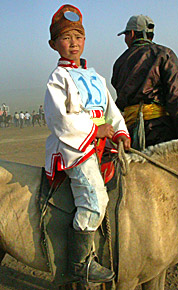 Herders and horse riders from the farthest reaches of Mongolia migrate to the
capital for the annual Naadam. That's short for Eriin Gurvan Naadam, meaning the
"Three Manly Games," an ancient nomadic Olympics comprising archery,
horse riding and wrestling.
Herders and horse riders from the farthest reaches of Mongolia migrate to the
capital for the annual Naadam. That's short for Eriin Gurvan Naadam, meaning the
"Three Manly Games," an ancient nomadic Olympics comprising archery,
horse riding and wrestling.
Held annually around National Day, July 11-13, Naadam brings the steppes to a standstill. True, not much braking is required as life in Mongolia is hardly fast-paced.
Still, shops close, picnic sacks are prepared, and a fair share of the population gleefully packs the ger (round, tent-like felt huts) into the back of a Medieval-era wagon, hitches the family yak, and begins the long hike to the national celebrations.
Sandwiched between the opening parade and a stadium music finale are two solid days of uniquely Mongolian sporting events, barely changed for centuries.
A total of 512 wrestlers square off in do-or-die matches in the stadium. Archers with attire and gear that predate Robin Hood skillfully aim at tiny, distant targets.
Perhaps most riveting are the horse races. Mongolians joke that their offspring ride before walking. Children as young as six race, some bareback, pounding along the plains for 20 kilometers. Among thousands of spectators lining the remote track are scores of toddlers confidently astride the small but sturdy Mongolian steed.
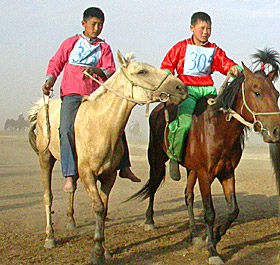 Such equestrian skills won Genghis Khan
an empire that stretched from the Sea of Japan all the way to Europe.
Such equestrian skills won Genghis Khan
an empire that stretched from the Sea of Japan all the way to Europe.
Many credit his ancient cavalry for speeding the pace of civilization, since fear of these new flash attacks sent walls rising around cities, and crops became more collectively cultivated. Everywhere, that is, except here. After conquering much of the world, Mongols retreated to their nomadic roots, compact but comfortable gers, and their magnificent horses.
But grandeur has been missing in recent years. The end of seven decades of Soviet-installed Communism in 1990 ushered in brief euphoria along with notions of democracy and free-market reform.
Mostly, though, Mongolians faced long lines and shortages of everything from petrol to bread and matches. Life improved somewhat in the mid-1990s, but a series of major storms over the last few winters have decimated the livestock that provide the major portion of Mongolian food and livelihood.
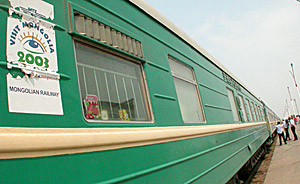 With the proclamation of the "Year
of Mongolia" tourism campaign, the authorities hoped this summer would be a
turning point. But since the campaign's launch in May - believed to be a
tourist-friendly time to start such a promotion, as temperatures finally topped
freezing - little actual promotion has been done.
With the proclamation of the "Year
of Mongolia" tourism campaign, the authorities hoped this summer would be a
turning point. But since the campaign's launch in May - believed to be a
tourist-friendly time to start such a promotion, as temperatures finally topped
freezing - little actual promotion has been done.
In any case, SARS in China has scared away most tourists, who transit via Beijing. Naadam visitor numbers are down a third, and tourism overall -- numbering a mere 25,000 per year for the entire country -- might be halved.
Hence,
Naadam, more then ever, seems a vital link to old glory, when the great Khan
himself reportedly proclaimed the games, and planted the Nine Yak Tails, a group
of ceremonial staffs signifying the uniting of the nine tribes of Mongolia.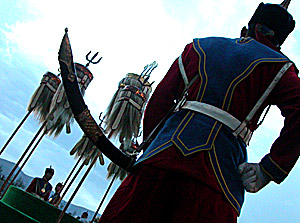
Similar staffs were carried in mid-July by mounted guard in red-and-blue finery that could put Buckingham Palace to shame, from the Parliament to the Central Stadium.
Steeped in ritual, Naadam custom requires participants to pay homage to the spirits in many ways. Horse riders circle a group of flags, chanting before each race. Wrestlers dance around the Nine Yak Tails, before and after every match, arms flapping in the devekh, or eagle dance.
Long on ceremony, Mongolian wrestling is wretchedly short on action, at least to non-Mongol observers. "Supremely boring," says one Canadian. "Clearly, American football isn't the slowest sport on Earth," adds a British tourist.
Wrestlers are massive tree-trunks of manhood, rolls of muscle or fat exploding over bikini trunks, either blue or pink. They wear leather boots, a kind of open-front leather vest and the traditional pointy-topped Mongolian hat.
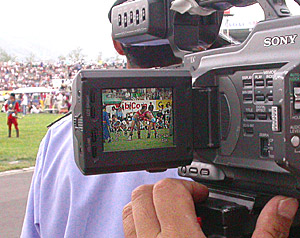 Clearly, combatants arrive dressed to kill. They just don't do much else.
Matches generally feature a few seconds in which wrestlers circle in a slow-motion
scrum, punctuated by endless breaks for conferences with coaches.
Clearly, combatants arrive dressed to kill. They just don't do much else.
Matches generally feature a few seconds in which wrestlers circle in a slow-motion
scrum, punctuated by endless breaks for conferences with coaches.
Mongols claim that it's all about strategy. False moves are critical, since the first wrestler who touches the ground with any part of his body except the hand or foot is out.
One semi-final match lasts two hours, with perhaps 10 minutes of activity. "A great battle," proclaims one excited Mongolian, adding that past matches have lasted four hours.
Some blame the tedious pace for a dwindling interest in the national sport. In response, new rules place time limits on early marches. Still, young Mongolians are increasingly turning to modern entertainment: movies, discos and Western sports broadcasts.
"Nobody in this generation is interested in Naadam," says Chinizorg, a 26-year-old tour guide. "We'd rather listen to hip-hop," adds Jargal, fresh out of college, sipping beer at the terrace of the crowded beer-pub, Khanbrau. "Naadam is just old-fashioned."
But Yura Enktuvshin, a wrestling fan, disagrees. "All my friends are here," he says. "And if not, they are watching this on TV. Naadam is the most important thing to Mongolians.
"Anyone who tells you otherwise is just trying to be cool," he insists.
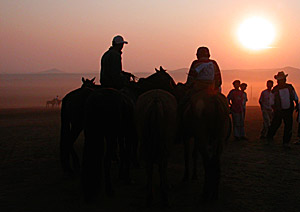 Indeed, even with an astonishing array
of cafes and pubs in Ulaan Baatar, most hotels and restaurants have televisions
tuned to Naadam throughout the weekend.
Indeed, even with an astonishing array
of cafes and pubs in Ulaan Baatar, most hotels and restaurants have televisions
tuned to Naadam throughout the weekend.
Out on the steppes, far from the world's coldest capital city, vast numbers of Ulaan Baatar residents in western dress fight to get close enough to slap the rear of winning horses, as the sweat supposedly brings good fortune all year.
In Mongolia, for easing the disappointment of a long winter and lack of summer tourists, a few drops of horse sweat still go a long way.
Ron Gluckman is an American journalist based in Hong Kong, who travels widely around the Asian region for a variety of publications, including the Asian Wall Street Journal, which ran this piece in its Weekend Edition of July 18-20, 2003.
For a look at another Naadam over a decade ago, see the Alternative Olympics.
To return to the opening page and index

push here
[right.htm]